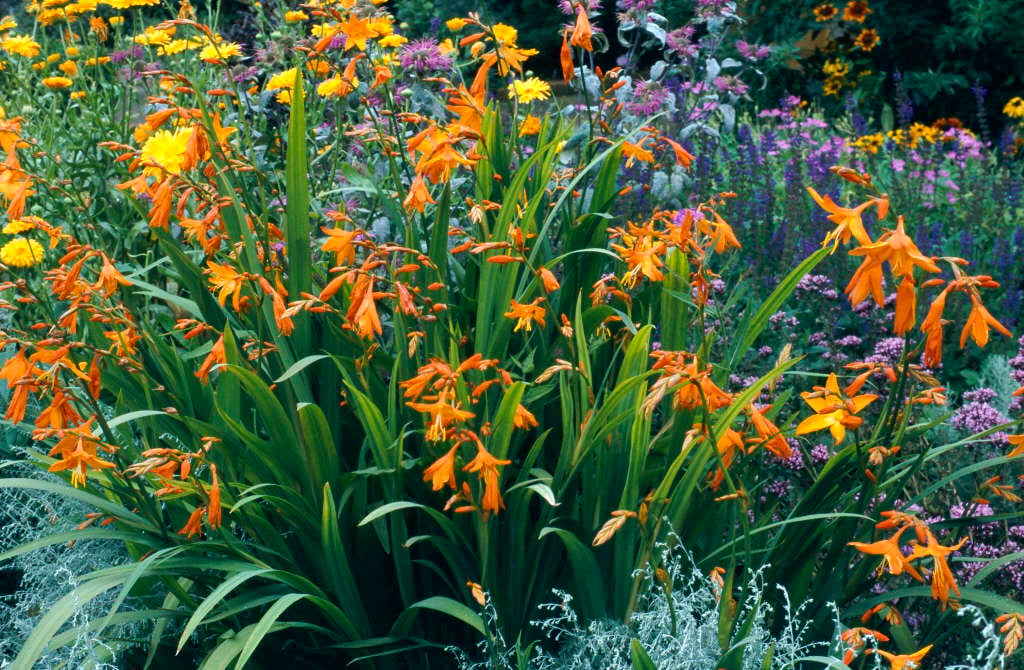Crocosmias form dense clumps of upright sword-shaped foliage, from which sprays of brightly coloured flowers, carried in branched spikes, appear in late summer.
Croscosmia Star of the East bears upright swords of orange flowers with pale yellow centres, from late-summer to autumn. Its ideal for growing in swathes through the herbaceous border, particularly in hot or tropical planting schemes, and the flowers are excellent for cutting.
Grow Croscosmia Star of the East in well-drained soil in full sun. In colder regions choose a sheltered site and mulch the corms in autumn to protect them over winter. Divide congested clumps in spring.
Crocosmia ‘Star of the East’ is a showstopping variety that has captivated gardeners for over a century. With its huge, vibrant blooms and ease of care, it’s no wonder this crocosmia is still one of the most beloved on the market. In this article, we’ll explore why crocosmia ‘Star of the East’ has remained a gardening staple after all these years.
A Brief History
Crocosmia ‘Star of the East’ was introduced way back in 1912 by a British nursery owned by George Davidson He instantly recognized the wow factor of this variety, with its flowers measuring a whopping 3-4 inches across – the largest blooms ever seen on a crocosmia at the time!
In the 1940s, crocosmia ‘Star of the East’ was awarded the prestigious Award of Garden Merit by the Royal Horticultural Society. This honor is only bestowed on plants that demonstrate excellence for ordinary garden use. Clearly this crocosmia variety was already making its mark decades ago.
David Fenwick, a leading crocosmia expert who cultivated the UK’s National Collection of Crocosmia, ranked ‘Star of the East’ as number two on his list of top ten crocosmias of all time. That’s some seriously high praise!
Vibrant Blooms
Without a doubt, the main claim to fame of crocosmia ‘Star of the East’ is its spectacular blooms. The flowers are a burnt orange hue, evoking a brilliant flame. When they first emerge, the buds are a clay-like reddish-orange. As the blooms open up, they reveal a softer orange interior with a creamy yellow throat. The petals are elegantly folded and slightly cupped, with a subtle fragrance.
The blooms are carried on arching spikes above the foliage, adding vibrant pops of color in the late summer garden. Flowers appear from early to mid summer and last for up to 10 weeks. Deadheading promotes even more blooms.
What’s extra special about crocosmia ‘Star of the East’ is that the flower spikes produce an abundance of bird-friendly seed pods after the main flowering period ends. These provide visual interest and food for birds in the fall.
Ideal Growing Conditions
Crocosmia ‘Star of the East’ thrives in zones 6-10, preferring full sun to partial shade. It reaches an impressive height of 30-36 inches when mature. The sword-like leaves remain attractive even when not in bloom.
This crocosmia grows best in well-drained soil and appreciates regular watering. Apply a balanced fertilizer in early spring. Plant the corms 2-3 inches deep and 8-10 inches apart once the threat of frost has passed.
Where winters are harsh, lift and store the corms in a cool, dry spot until ready to replant in spring. Otherwise, mulch the roots for winter protection. Divide congested clumps every few years to promote flowering.
Perfect for Cutting Gardens
The strong, upright flower stems of crocosmia ‘Star of the East’ make it an ideal choice for cutting gardens. The blooms last up to two weeks in bouquets and bring a bold pop of color to arrangements.
Some other excellent cut flower crocosmia varieties include ‘Emily McKenzie’, ‘Lucifer’, and ‘Solfaterre’. But none can match the magnificence of ‘Star of the East’!
An All-Star Perennial
It’s clear why crocosmia ‘Star of the East’ has been treasured by gardeners since its introduction well over a century ago. Once established, it rewards the grower with an abundance of lasting, fiery blooms year after year with minimal care required. This tough, versatile perennial continues to shine bright, fully deserving its stellar reputation.
In your own garden, make room for the dazzling crocosmia ‘Star of the East’ and enjoy its sparkling summertime display!

Crocosmia ‘Star of the east’ and wildlife
Crocosmia ‘Star of the east’ is known for attracting bees. It has nectar/pollen rich flowers.
